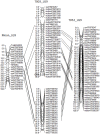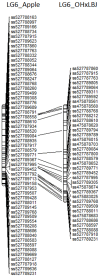Identification of Pyrus single nucleotide polymorphisms (SNPs) and evaluation for genetic mapping in European pear and interspecific Pyrus hybrids
- PMID: 24155917
- PMCID: PMC3796552
- DOI: 10.1371/journal.pone.0077022
Identification of Pyrus single nucleotide polymorphisms (SNPs) and evaluation for genetic mapping in European pear and interspecific Pyrus hybrids
Abstract
We have used new generation sequencing (NGS) technologies to identify single nucleotide polymorphism (SNP) markers from three European pear (Pyrus communis L.) cultivars and subsequently developed a subset of 1096 pear SNPs into high throughput markers by combining them with the set of 7692 apple SNPs on the IRSC apple Infinium® II 8K array. We then evaluated this apple and pear Infinium® II 9K SNP array for large-scale genotyping in pear across several species, using both pear and apple SNPs. The segregating populations employed for array validation included a segregating population of European pear ('Old Home'×'Louise Bon Jersey') and four interspecific breeding families derived from Asian (P. pyrifolia Nakai and P. bretschneideri Rehd.) and European pear pedigrees. In total, we mapped 857 polymorphic pear markers to construct the first SNP-based genetic maps for pear, comprising 78% of the total pear SNPs included in the array. In addition, 1031 SNP markers derived from apple (13% of the total apple SNPs included in the array) were polymorphic and were mapped in one or more of the pear populations. These results are the first to demonstrate SNP transferability across the genera Malus and Pyrus. Our construction of high density SNP-based and gene-based genetic maps in pear represents an important step towards the identification of chromosomal regions associated with a range of horticultural characters, such as pest and disease resistance, orchard yield and fruit quality.
Conflict of interest statement
Figures





References
Publication types
MeSH terms
Substances
LinkOut - more resources
Full Text Sources
Other Literature Sources

